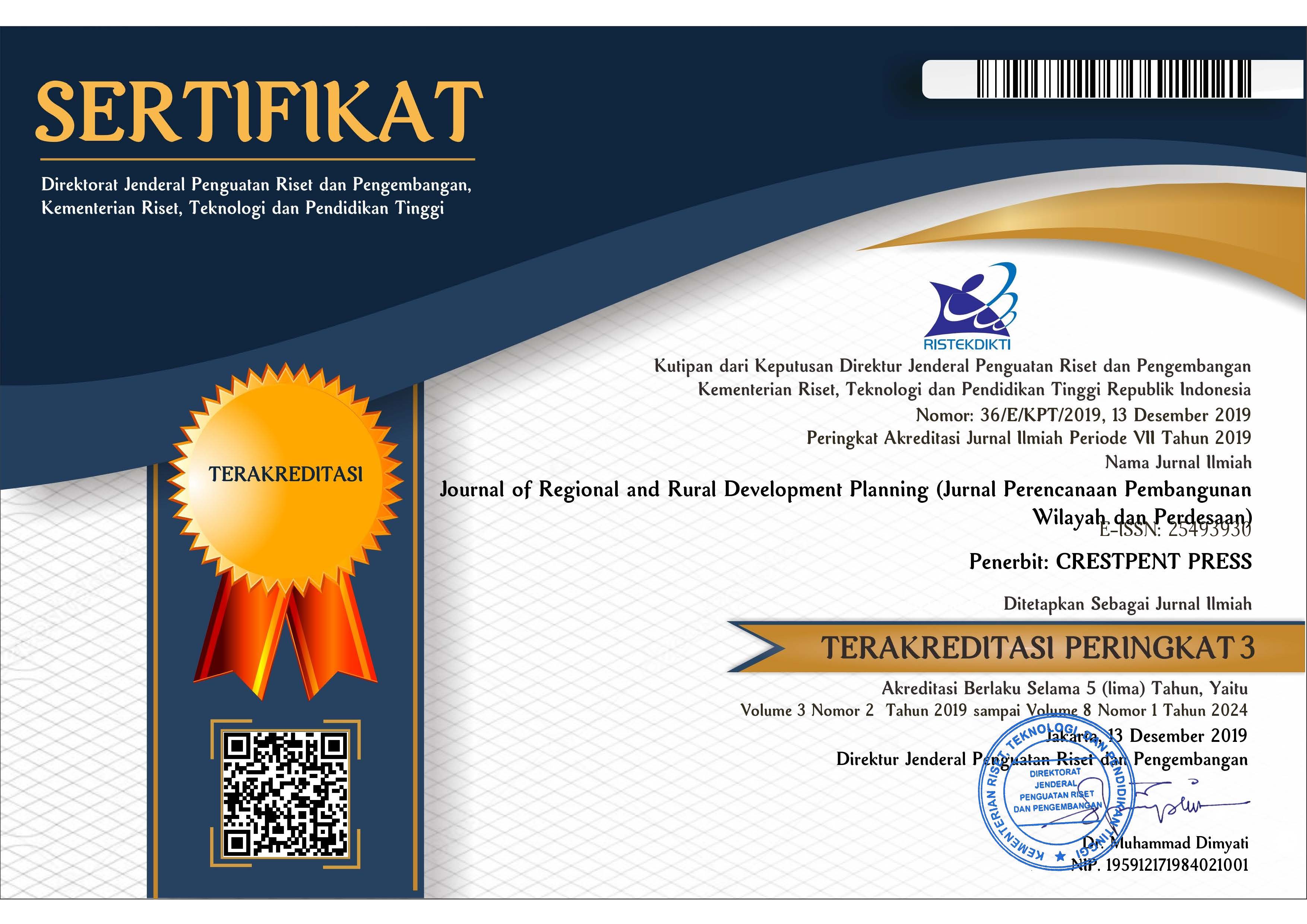Issues and Problems Faced by Rural Farmers in Paddy Cultivation: A Case Study of the Iban Paddy Cultivation in Kuala Tatau, Sarawak
DOI:
https://doi.org/10.29244/jp2wd.2017.1.2.174-182Keywords:
agriculture, paddy, rural, Sarawak, sustainabilityAbstract
Rice is an important staple food in Asia. However, modernization and rapid development have reduced and threatened the practice, especially maintaining traditional hill rice cultivation, as in this case study by the Iban in Kuala Tatau located in the largest state in Malaysia, called Sarawak. It is important to understand the problems and challenges of this issue to ensure food security among the rural population in Sarawak, particularly the Iban. Therefore, this paper aims to discuss the issues and problems faced by rice farmers in Kuala Tatau, Sarawak. The respondents were Iban farmers in Kuala Tatau; named Sungai Semanok and Kuala Serupai, were selected as it is at a great distance from urban areas named Bintulu, and they still practices paddy cultivation. For the purpose of obtaining the data, qualitative research methods through in-depth interview techniques, group discussion and observation were utilized and the data were analyzed using content analysis. The results showed that the rice sector faced major problems such as the decrease of the number of farmers and a weak system in the distribution of subsidies. However, there were differences shown in results between the two villages as well, which were in term of inadequate agricultural land, and issues on drainage and irrigation system, depending on the distance of the village from urban area, transport facilities, and other issues as discussed in the following section.References
Berma, M. (1955). Towards the National Vision Policy: Review of the Economic Policy and New Development Policy among the Bumiputera Communities in Sarawak. Journal of Malaysian Studies, 21(1), 2004, 211-256.
Chambers, R. (1997). Whose Reality Counts? Putting the First Last. London: Intermediate Technology Publications.
Chamhuri, S. & Chamhuri, N. (2009). Strategi dan Prospek Mencergas Semula Sektor Pertanian Negara. Ekonomi Malaysia ke Arah Pembangunan Seimbang. Idris, N. A. H. & Yussof, I., Ed. Pp. 282-315. Bangi: Penerbit UKM.
Ellis, F. (1998). ‘Survey article: Household strategies and rural livelihood diversification’. The Journal of Development Studies. 35 (1), 1–38.
F. Derek. (1970). Report of the Iban, 140‒142. London: The Athlone Press, University of London.
Freeman, J.D. 1955. Iban Agriculture: A Report of the Swidden system of Hill Rice by the Iban of Sarawak. London: H. M. Stationery Office.
Ghaffar A.G & Osman K. (1995). Values and development in Malaysian planning - a macro and micro perspective. Proceedings of the Fifth Malaysia Singapore Forum, Singapore.
Hong, E. (1987). Natives of Sarawak: Survival in Borneo’s Vanishing Forest. Malaysia: Institut Masyarakat.
Jackson, J. C. (1976). Sarawak. Kuala Lumpur: Dewan Bahasa dan Pustaka.
Jongudomkarn, D. & Camfield, L. (2006) Exploring the quality of life of people in North Eastern and Southern Thailand. Social Indicators Research 78, 489-529.
Kendawang, J.J., Tanaka, S., Soda, R., Logie, S., Wasli, M.E. & Sakurai, K. (2005). Difference of rice farming practices of the Iban in a national boundary area in Borneo and its socio-economic background. Tropics, 14: 295−307.
Kothari, U. (2005). Authority and expertise: the professionalization of international development and the ordering of dissent, Antipode, 37 (3).
Lawa A. S. & Okeowo T. A. (2014). Effects of Rural Urban Migration on Labour Supply in Cocoa Production in Ondo East Local Government Area of Ondo State. Academic Journal of Interdisciplinary Studies, 3 (7).
Majid, Z. (1982). The West Mouth, Niah in the Prehistory of Southeast Asia. Sarawak Museum Journal 31 (52 n.s), Special Monograph No. 3.
Masron, T., Fujimaki, M., & Ismail, N. (2013). Orang Asli in Peninsular Malaysia: Population, Spatial Distribution and Socio-Economic Condition. J. Ritsumeikan Soc. Sci. Hum. 6, 75-115.
Spencer, J. (1966). Swidden system in Southeastern Asia. California: University of California Press.
Stiglitz, J. (1969). Rural-urban migration, surplus of labour and the relationship between urban and rural wages. The Eastern Africa Economic Review 2: 1-28.
RECODA. (2015). SCORE Areas. Sarawak Corridor of Renewable Energy. http://www.recoda.com.my/invest-in-score/score-areas/ [12 January 2015].
Tabutin, D. & Schoumaker, B. (2004). The Demography of Sub-Saharan Africa from the 1950s to the 2000s. A Survey of Changes and a Statistical Assessment. Population-E, l (59), 455-555.
Taib, M. (1989). Iban Cultural Heritage in the Context of Present Day Malaysia. Sarawak Museum Journal. 2.
Todaro, M.P. (1969): A model of labour Migration and Urban Unemployment in less developed Countries. American Economic Review March.
Ugih, D. (2014). Sustainable Development, Local Knowledge and Cultural Systems In Agriculture: Case Study Of Iban Farmers at Kuala Tatau, Bintulu, Sarawak. Thesis. Universiti Sains Malaysia.
Walton, J. R. (1990). The Economic Structure of Sarawak. Margins and Minorities: The Peripheral Areas and Peoples of Malaysia. King, V. T. & Parnwell, M. J. G., Ed. 130-146. Hull: Hull University Press.

















.png)




